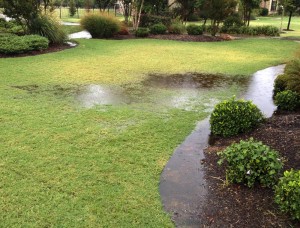Good drainage in the landscape is as important as proper irrigation. In the Dallas area, we often have torrential rains followed by months of searing heat. Dallas cloudbursts can overwhelm any drain system. Too much water in landscaped areas during wet weather  months can result in numerous plant diseases – and can even kill sensitive plants. Overly wet turf areas are prone to soil compaction and scarring from footprints and mowing equipment.
months can result in numerous plant diseases – and can even kill sensitive plants. Overly wet turf areas are prone to soil compaction and scarring from footprints and mowing equipment.
In addition, drainage around buildings is important to prevent leaks and moisture intrusion into building foundations and walls.
Surface drainage systems aim to collect excess surface water from hardscaping, planter beds, window wells, and specific turf areas where water tends to collect. Water enters a surface landscape drainage system through catch basins, which have a sump area that collects debris to prevent clogging of the piping.
Commonly Used Landscape Drainage Systems in the Dallas-Fort Worth Area (972)231-4675
Catch basins and the drainage grates that go on top of them are available in a variety of sizes and styles depending upon the application.
Round drainage grates are used in turf areas.
Square drainage grates are used for hardscaped areas; walkways, driveways, parking lots, around swimming pools, etc.
Atrium drainage grates have a raised “domelike” design to prevent debris from building on top of the grate openings. These are used in window wells, planter areas, and other applications where bark mulch, stone, or landscape debris would tend to cover drain openings.
The size of the catch basin should be sized to the anticipated volume of water to be collected. In addition, the pipe carrying the water from the catch basin should be properly sized to carry water from all catch basins to which it is connected. Always size a little larger than necessary for safety. The additional material cost is minimal and mistakes can be costly. If the drain will be exposed to weight or traffic from above, you may need to consider a concrete catch basin and/or a metal drainage grate. The drainage line connecting the catch basins should be of a solid (non-perforated) design. Both solid PVC and corrugated plastic piping are acceptable.
Another form of the surface drainage system is the channel drain. Channel drains are frequently used in paved areas to collect water. They are essentially an extended trough or catch basin covered by a long grate. Typical channel drains can be 10’ long and 4″ wide. Channel drains are also connected together with solid piping.
Sub-Surface Landscape Drainage
The most frequently used form of sub-surface drainage is the French Drain or underground collection drain. This drain collects underground water from saturated soils and carries it to the desired destination. Sub-surface drains help carry water away from low spots and can protect drainage sensitive plant material.
Downspout Landscape Drainage
Drain lines can be used to carry roof water from downspouts away from buildings and planting beds. Downspout drain lines can be especially helpful if the natural grade around a building does not cause water to move away from the foundation. Downspouts can be connected to solid PVC or corrugated plastic drain pipes to carry roof water away from the building.
French Drains
French Drains collect sub-surface water from poorly drained areas and carry it to the main drainage line, dry well, ravine, or the street. French drains can intercept water that is draining from adjacent properties and carry it away before it enters your landscape.
It is constructed using simple materials: pea gravel or crushed rock, woven landscape fabric, and a perforated drainage pipe (usually the corrugated variety).
To create a French Drain, dig a trench that will carry water away from the area to be drained. Ideal places to put French Drains are the bases of slopes, along retaining walls, or any other area where water tends to collect. Make certain that your trench is well sloped so that water is encouraged to move through the drain to the desired destination.
Line the trench with landscape fabric. Install a 4″ or 6″ perforated drain line at the bottom of the trench, and backfill with gravel. The landscape fabric should be wrapped all of the ways around the gravel to prevent the mixing of the surrounding soil into the gravel. This will keep the porous spaces in the gravel open for the water to flow through.
In areas with severe drainage problems, multiple perforated lines are used as water collectors or interceptor drains. Water enters the perforations in the drain lines when the surrounding media is saturated and can be carried away more quickly than just by percolating through the gravel.
If desired, you can connect the perforated lines into a main, non-perforated header line to collect and carry the water to it’s intended destination.